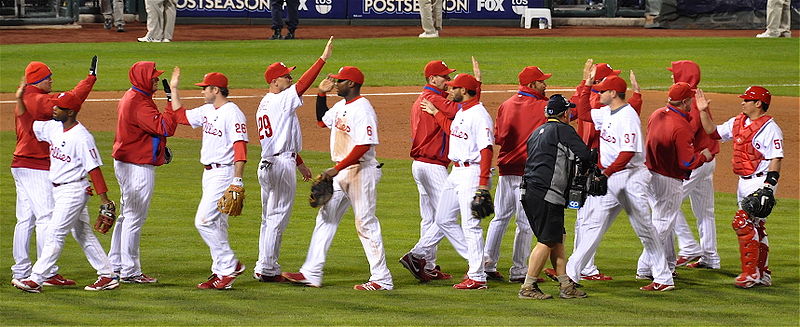2019 was supposed to be a big year for the Phillies. They acquired Bryce Harper, the biggest free agent of the offseason. They further solidified an already-promising lineup with other new faces, including an aging but still perfectly fine Andrew McCutchen, and one of the best catchers in baseball in J.T. Realmuto. Plus, Gabe Kapler was starting his second season as skipper — while he wasn’t overtly bad in 2018, there were some growing pains, and ideally a young manager learns from past mistakes. That’s the hope anyway. Accordingly, the Phillies were expected to be good in 2019, and were picked by more than a few to make their first trip to the postseason since 2011 — the last time they had a record above .500.
It didn’t happen. Maybe it was bad luck. McCutchen had a season-ending ACL injury in early June when the Phillies were a game up in the NL East, and they had a hard time finding his replacement at the leadoff spot. The biggest issue, however, was that the Phillies weren’t quite ready to compete with their below-average pitching staff in what turned out to be a very tough division, even with the company of the lowly Marlins. The Phillies finished 81-81, and in a discouraging 4th place. Kapler was axed and is now managing in San Francisco.
Less notable, although not to this author, was the Phillies’ minus-20 run differential in 2019. And here’s why that’s very important: Since 1901, the Phillies have a minus – a negative – 6,528 run differential, easily the biggest hole in all of baseball. They’ve lost on average nearly 55 runs a year for 119 seasons. Here, take a look:
1901-2019

(God bless the Padres. Only been in existence since 1969, yet right there in the Bad Run Differential Final Four.)
So in the end, even a should-be promising season like 2019 resulted instead in a few more runs for teams who were not the Phillies. How did such a historic and proud franchise like this one wind up here? Well, when sorting by National League teams with the worst run differential in history, the Phillies have six in the top ten. They’ve been prolifically bad. Especially in the 1920s, a decade in which the Phillies allowed more than 2,000 runs than they themselves managed to score. That’s not easy to do. The 1940s weren’t much better, with nearly 1,800 fewer runs than the competition. So again, they’ve been very bad. A lot of it happened a long time ago but they’ve been very bad nonetheless.
And that brings us to today’s question: How long will it take the Phillies to correct this? To climb out of this gargantuan hole and have a positive — or at least a zero — run differential for their franchise’s history? I’ve suggested three answers below, starting with the most optimistic to the least, albeit most likely, scenario.
- In 31 years, or by 2051
In 1976, an appropriate year for Philadelphia’s home team to be good, the Phillies won 101 games and an old NL East title before being swept in the division series by the eventual champs, the Big Red Machine era Cincinnati Reds. That notwithstanding, powered by sluggers like Mike Schmidt and Dick Allen, and a pitching staff fronted by Steve Carlton that was one of the best in baseball, the Phillies had a positive 213 run differential for the year. That’s a franchise record and the 30th best mark in the NL dating back to 1901.
Extrapolate that +213 over 31 years and the Phillies would finally have a positive run differential. Now, this is quite unlikely for a myriad or reasons, but they’ve done it once, they can do it again…31 times in a row.
- In 120 years, or by the year 2140
Look, it took the Phillies 120 years to rack up -6,528 runs, give them another 120 years and surely they can do that “For Every Action, There’s An Equal And Opposite Reaction” thing. This is a franchise that is certainly well-funded. They play in front of passionate fans who, say what you want, but they demand nothing but the best and will let the powers-that-be know if they’re not delivering. I suspect there will be plenty of pressure on whoever occupies ownership and the front office over the next twelve decades to deliver a winning product, a sentiment that perhaps wasn’t quite there during the first half of the 20th century. Now, I wasn’t alive during the first half of the 20th century, so who really knows, but the world from 1900-1950 had much worse problems than crappy baseball teams so this all sounds sensible enough.
And during this current century, the Phillies are sitting at a positive run differential of 60. That’s not much, but still, the Phillies largely have a “before any of us were even born” problem. These are not our grandparents’ Phillies, these Phillies are mostly fine.
- Never
Never. Of course never. With pending labor wars, real wars, climate change, you name it, there are simply not enough years left of this sport (or planet) for such a summit to even be scaled. And even if we had infinite years of baseball in front of us, the negative run differential is just so massive that the Phillies will always be in the red. And that’s okay. Start winning a few NL East titles again and no one will really care. (No one besides me really cares anyway.)
**********
Look for updates to this post in 2051, 2140, and at the end of times to see where things stand. Until then, good luck, Phillies.
Credit to Baseball Reference’s invaluable Play Index for allowing such silly stats to be available.
Next post: Gotta Go Fast…to Cooperstown: The Case for Kenny LoftonPrevious post: Evaluating the 2019 Predictions & Projections





Leave a Reply